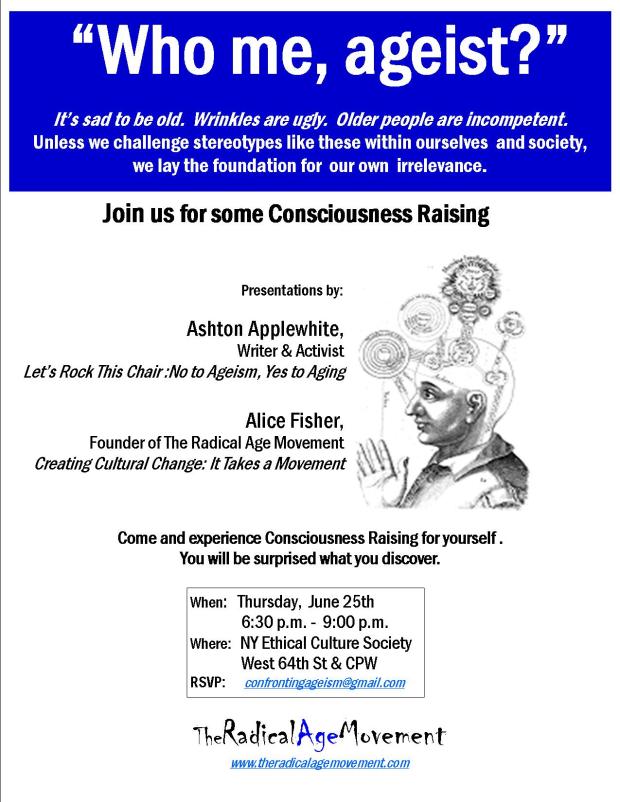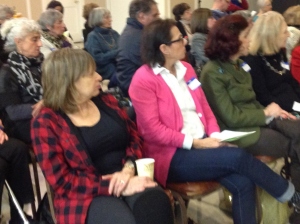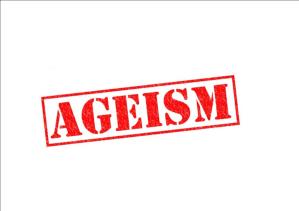by Alice Fisher, M.S.W.
Last week Bill Maher’s closing editorial comments were about ageism, identifying it as the ‘last acceptable prejudice in America’. Ageism might be more accurately described as the ‘least acceptable prejudice in America’. Why? When a person uses ageist language, he is expressing prejudice against himself. Age, after all, is a goal we aspire to; it is a goal, if we are fortunate, that we will achieve. And, yet, in our youth focused and youth obsessed society, the message we get is more like “be careful what you wish for.”
If one is fortunate enough to reach old age and become a repository for all the wisdom that living a long life imparts, one must also be prepared to become the subject of incessant stereotyping and ridicule that accompanies growing old in a culture that imparts the message that young equals good, while old equals bad.
What should older people like Jerry Brown do with all the knowledge they have accumulated? Shall they take their years of experience with them into a world where young and old are segregated so that the knowledge of the old cannot contaminate the eagerness of the young? Generativity, the ability of the old passing on knowledge and experience to the young, was once the pride of generations. Today, it seems that every new cohort of human beings can ‘do it themselves’.
What, I began to think, would a world be like with no old people? For the purpose of pondering this question, let’s define old as anyone over 65. Remember, when they leave, they take all their years of experience and wisdom with them. After all they worked hard to achieve it all. It belongs to them. Next, they take all of the wisdom passed down from past generations with them also. They had no opportunity to pass it on, so they may as well keep it. It may come in handy.
With no people over 65, there would be no way to see the magnificent lines of experience and wisdom that symbolize a full life lived. If we lived in a society that had no people over 65, we would never have the opportunity to know the possibility of fulfillment from helping a loved one who is at the end of a full life lived. Nobody in a society that excludes older adults would have to be confronted with their own ageing…no gray hair, no wrinkles, no walkers, no age spots, no diminishment of abilities. And, best of all for American society, we would never have to face our own death…or, at the least, we would be able to put it off as long as possible.
When I was 15 years old my grandfather passed away, and my grandmother came to live with us. I loved to join her in her room in the evenings and listen to the stories of “the old country”. She told me about coming to America. She filled me with stories about my mom and her brothers and sister growing up in Brooklyn and stories about her own brothers and sister, my great aunt and uncles. She taught me how to bake the same cookies that her mother taught her, and I just recently passed the recipe down to my own granddaughter. Most precious of all was the unconditional love that she bestowed upon me and the rest of our family. All of these experiences certainly had a great impact in shaping who I am today. When she did become ill and knew that her life was coming to an end, she gave me the gift of learning about death which included the message that it was okay.
If we lived in a world where there were no older adults, the best of some of the world’s greatest thinkers would remain unknown, with nothing for future generations to build on. There would be no Grandma Moses, no success for Mahatma Ghandi. Nations would have no access to the experience of a Golda Mier or a Nelson Mandela. We would never experience the complete genius of a Benjamin Franklin or a Charles Darwin. We would never know what a full life could mean. Everyone would leave a life cut short.
We need to consider the wonderful, and sometimes great, gifts that older people give to our society, our communities, and not the least, to our families. Below is just a short sample of some of the wonderful contributions we have received from the older adults who had the privilege of living and sharing a full life.
At 100, Grandma Moses was painting.
At 94, Bertrand Russell was active in international peace drives.
At 93, George Bernard Shaw wrote the play Farfetched Fables.
At 91, Eamon de Valera served as president of Ireland.
At 91, Adolph Zukon was chairman of Paramount Pictures.
At 90, Pablo Picasso was producing drawings and engravings.
At 89, Mary Baker Eddy was directing the Christian Science Church.
At 89, Arthur Rubinstein gave one of his greatest recitals in New York’s Carnegie Hall.
At 89, Albert Schweitzer headed a hospital in Africa.
At 88, Pablo Casals was giving cello concerts.
At 88, Michaelangelo did architectural plans for the church of Santa Maria degli Angeli.
At 88, Konrad Adenauer was chancellor of Germany.
At 85, Coco Chanel was the head of a fashion design firm.
At 84, Somerset Maugham wrote Points of View.
At 83, Aleksandr Kerensky wrote Russia and History’s Turning Point.
At 82, Winston Churchill wrote a History of English Speaking People.
At 82, Leo Tolstoy wrote I Cannot Be Silent.
At 81, Benjamin Franklin effected the compromise that led to the adoption of the U.S. Constitution.
At 81, Johann Wolfgang von Goethe finished Faust.
At 80, George Bums won an Academy Award for his performance in The Sunshine Boys.
Avery, A. C., et al. Successful Aging. New York. Ballantine Books, 1987.












 “I came to the realization that the extra years many of us will be living are not tacked on to the end of our lives. Rather, a whole new stage of life has opened up along the life span, and those are people between approximately 60 and 80 years of age who are still a vital and relevant part of our society.” “We”, said Fisher who is 69 years old, “are not ready to throw in the towel.” After being asked, “how do you change an entire culture”, her response was “with a movement. It’s the only way we’ve ever done it.” Right then and there the seed for The Radical Age Movement was planted.
“I came to the realization that the extra years many of us will be living are not tacked on to the end of our lives. Rather, a whole new stage of life has opened up along the life span, and those are people between approximately 60 and 80 years of age who are still a vital and relevant part of our society.” “We”, said Fisher who is 69 years old, “are not ready to throw in the towel.” After being asked, “how do you change an entire culture”, her response was “with a movement. It’s the only way we’ve ever done it.” Right then and there the seed for The Radical Age Movement was planted.

